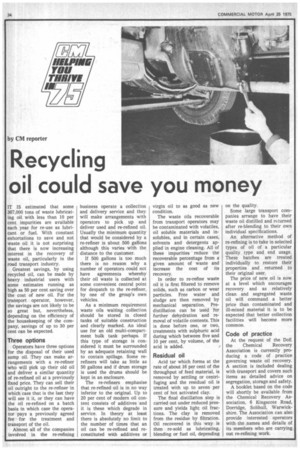Recycling oil could save you money
Page 36

If you've noticed an error in this article please click here to report it so we can fix it.
by CM reporter IT IS estimated that some 367,000 tons of waste lubricating oil with less than 10 per cent impurities are available each year for re-use as lubricant or fuel. With constant exhortations to save and not waste oil it is not surprising that there is now increasing interest in the recovery of waste oil, particularly in the road transport industry.
Greatest savings, by using recycled oil, can be made by heavy industrial users with some estimates running as high as 50 per cent saving over the cost of new oil. For the transport operator, however, the savings are not likely to be so great but, nevertheless, depending on the efficiency of the housekeeping of the company, savings of up to 30 per cent can be expected.
Three options
Operators have three options for the disposal of their used sump oil. They can make arrangements with a re-refiner who will pick up their old oil and deliver a similar quantity of re-refined oil at a previously fixed price. They can sell their oil outright to the re-refiner in which case that is the last they will see it it, or they can have the oil re-refined on a batch basis in which case the operator pays a previously agreed fee for the treatment and transport of the oil.
Almost all of the companies involved in the re-refining business operate a collection and delivery service and they will make arrangements with operators to pick up and deliver used and re-refined oil. Usually the minimum quantity that would be considered by a re-refiner is about 500 gallons although this varies with the distance to the customer.
If 500 gallons is too much there is no reason why a number of operators could not have agreements whereby their oil waste is collected at some convenient central point for despatch to the re-refiner, by one of the group's own vehicles.
As a minimum requirement waste oils waiting collection should be stored in closed tanks of suitable construction and clearly marked. An ideal use for an old multi-compartment bulk tank perhaps. If this type of storage is considered it must be surrounded by an 'adequate retaining wall to contain spillage. Some rerefiners will take as little as 50 gallons and if drum storage is used the drums should be kept in an enclosure.
The re-refiners emphasise that re-refined oil is in no way inferior to the original. Up to 20 per cent of modern oil content consists of additives and it is these which degrade in service. In theory at least there is absolutely no limit to the number of times that an oil can be re-refined and reconstituted with additives or virgin oil to as good as new condition.
The waste oils recoverable from transport operators may be contaminated with volatiles, oil soluble materials and insolubles, and in certain cases, solvents and detergents applied in engine cleaning. All of these impurities reduce the recoverable percentage from a given amount of waste and increase the cost of its recovery.
In order to re-refine waste oil it is first filtered to remove solids, such as carbon or wear particles. Free water and sludge are then removed by mechanical separation. Predistillation can be used for further dehydration and removal of volatile contents. This is done before one, or two, treatments with sulphuric acid during which between five and 10 per cent, by volume, of the acid is added.
Residual oil
Acid tar which forms at the rate of about 16 per cent of the throughput of feed material, is removed by settling or centrifuging and the residual oil is treated with up to seven per cent of hot activated clay.
The final distillation step is carried out under reduced pressure and yields light oil fractions. The day is removed from the residue by filtration. Oil recovered in this way is then re-sold as lubricating, blending or fuel oil, depending on the quality.
Some large transport companies arrange to have their waste oil distilled and rc:turned after re-blending to their own individual specifications.
An alternative method of re-refining is to take in selected types of oil of a particular quality type and end usage. These batches are treated individually to restore their properties and returned to their original user.
The price of new oil is now at a level which encourages recovery and as relatively clean and segregated waste oil will command a better price than contaminated and ill-mixed material it is to be expected that better collection facilities will become more common.
Code of practice
At the request of the DoE the Chemical Recovery Association is currently producing a code of practice governing waste oil recovery. A section is included dealing with transport and covers such items as detailed advice on segregation, storage and safety.
A booklet based on the code will shortly be available from the Chemical Recovery Association, 6 Kingscote Road, Dorridge, Solihull, Warwickshire. The Association can also provide interested operators with the names and details of its members who are carrying out re-refining work.




















































































